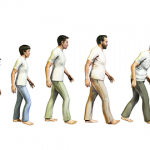Immune cell longevity is tightly connected to the functional integrity of telomeres, which are regulated by cell multiplication, exposure to oxidative stress, and DNA repair mechanisms. In patients with RA, telomerase deficiency is associated with premature immune aging. Lymphocytes are among the few cell types that can actively elongate telomeres through the action of telomerase, but premature telomere shortening in lymphocytes from patients with RA is seen because up-regulation of the telomerase enzyme is faulty in patients with RA.3 The deficiency in telomerase activity was found to be independent of the duration or severity of RA, suggesting that it may contribute to the development of RA.
Perhaps this may explain an interesting observation by our colleagues at the Mayo Clinic in Rochester, Minn. Using mathematical modeling techniques, they found evidence for accelerated aging in patients with RA.4 The best-fitting models consistently showed effective aging of two extra years at the time of diagnosis of RA and additional aging of 1.4 years for every 10 years of disease thereafter. The excess aging noted at the time of the diagnosis of RA suggests that an inflammatory or immunologic event or injury precedes the clinical presentation of RA, whereas the acceleration of aging finding supports the concept of senescence of the immune or other subsystems of the body following the development of RA.
Successful Aging: Clues from Centenarians
Is there a way to age gracefully? A Google search of this phrase generates over 2.5 million results. There is no shortage of interest in this topic, but there are few proven remedies. Vitamin supplements, low-calorie diets, and sirtuins hold some promise and, as our dermatologist colleagues remind us, a well-placed injection of botulinum toxin can at least temporarily reverse the effects of time. Perhaps we can gain some insight from the study of those individuals who have succeeded in aging gracefully. The New England Centenarian Study (NECS) was founded in 1994 as a longitudinal study of centenarians to identify clues to healthy human aging.5 The study, along with other databases, has demonstrated that the majority of centenarians markedly delay high mortality risk–associated diseases toward the ends of their lives, yet many centenarians have a history of enduring more chronic age-related diseases for many years, women more so than men. The majority of centenarians seem to deal with these chronic diseases more effectively, not experiencing disability until well into their 90s.
People who live to the most extreme ages are generally living proof of the compression-of-morbidity hypothesis. That is, they compress morbidity and disability to the very ends of their lives. The compression-of-morbidity hypothesis posits that preventive lifestyle behaviors, including regular exercise, will postpone disability by at least as much as it does mortality, thus compressing morbidity between a later onset and the age at death. To test this hypothesis, Jim Fries, MD, master member of the ACR, and colleagues at Stanford University devised a long-term study of runners aged 50 and older.6 Since 1984, these investigators have followed more than 500 runners, comparing them to an age-matched control group. After 19 years of follow-up, 15% of runners had died compared with 34% of controls. Following adjustments for covariates, runners demonstrated a survival benefit with a hazard ratio of 0.61. As participants approached their ninth decade of life, disability and survival curves continued to diverge between the two groups.



